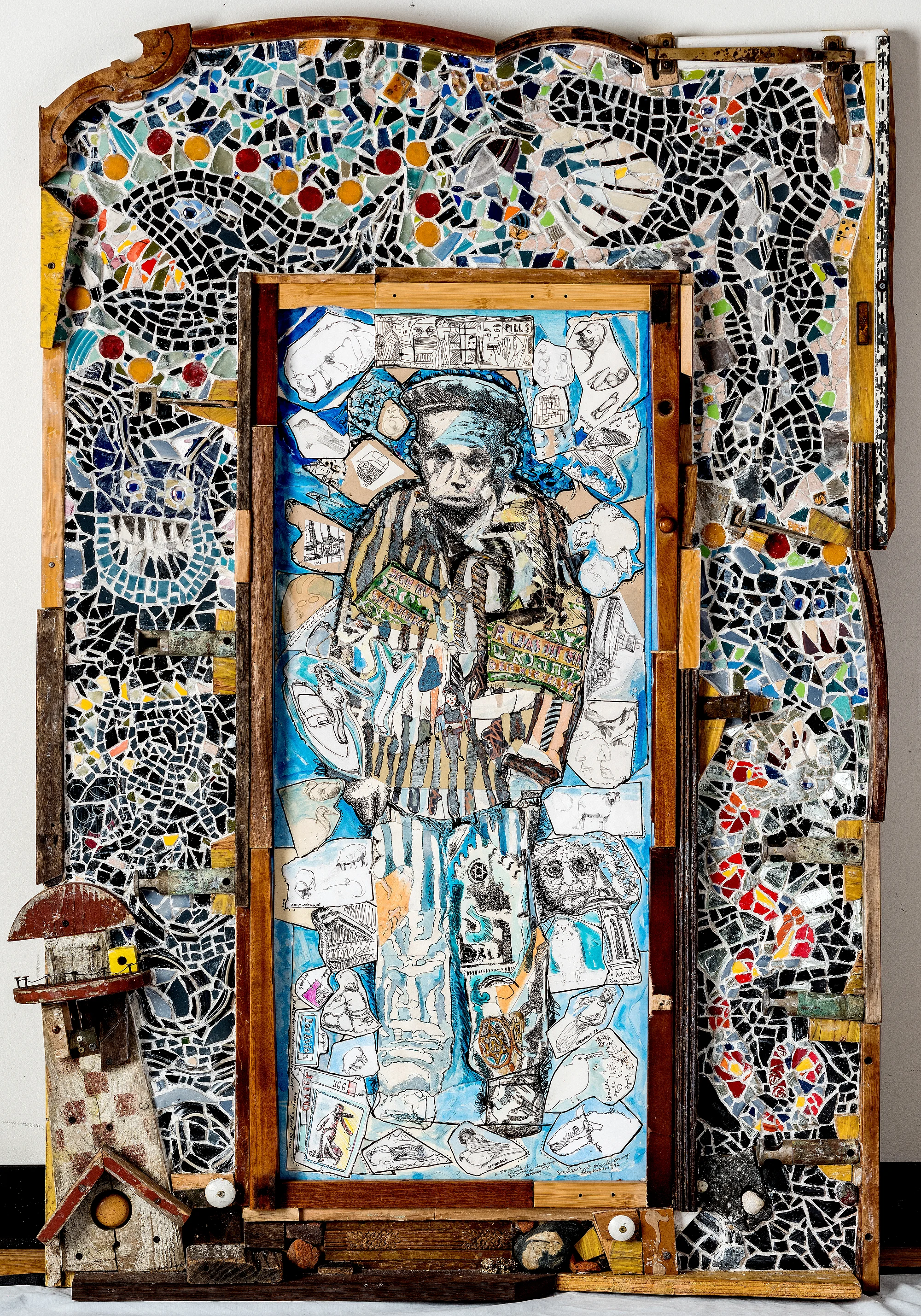Art © A K Segan
Art © A K Segan
UTW 65
I’m just knockin’ round the zoo…with sea monsters and a sea serpent…at the Buchenwald concentration-death camp, 1938.
Art: 2017
Media: Mosaic-drawing combo. The drawing paper is 42 inches H x 18 W
Size: 60 inches H x 42 W.
The man portrayed in the drawing was inspired by a photo of several Jewish disabled prisoners, Aktion T-4 inmates, in which are seen several Jewish disabled prisoners at the Buchenwald concentration-death camp, Germany, 1938. Regarding the identifying prisoner clothing badge:
Disabled Jewish inmates at that camp wore a black triangle on a yellow triangle for Nazi guard identification purposes. The Nazi hate usage meant "asocial Jews.”
~
The artwork title was inspired by a song in the James Taylor music album, titled James Taylor, published in a 33rpm album, 1968, published by Apple Records. The song title is Knocking ’round the zoo.
~
I surrounded the figure in my drawing with sketches from sketchbooks, ca. 1972, 1990-92, 2009. Also included are 2 small rough sketches, at left and lower left, for detail areas of 2 Under the Wings series artworks:
UTW 48: Italian Jewish resistance hero Eugenio Curiel, Castel Sant'angelo & my flying Chi, Obi Jew-Jew Kenobi (2002); UTW 51: Sorrows of Love - Homage to French surrealist poet and anti-Nazi activist Robert Desnos (2003)
~
Two depictions in the upper torso shirt area of the figure of the prisoner were inspired by a)
a black and white photo plate seen in the chapter Germany, in the book Jewish Art & Civilization (Chartwell Books, 1972). And b) the small image of a girl, in the center, was inspired by 2 plates in the Yad Vashem publication No Childs Play. One was a marionette made by 16 year old Jan Klein and his teacher Walter Freund, in the Terezin (Theresienstadt) concentration-death camp. The other photo is of a doll in prisoner's uniform, made by Roma Alter in the Auschwitz death camp.
~
Special thanks to Yad Vashem for correctly describing Auschwitz and Majdanek, as death camps.
Those (in the media, in the internet, e.g. Wikipedia’s Board of Trustees, and at educational institutions) who write of and call the Nazi death camps (as) "concentration camps" are harming tolerance and accurate education re the Holocaust by supporting and promoting an ever-increasing number of professional Holocaust deniers and their websites. How so? Professional Holocaust deniers love it when Auschwitz and other Nazi death camps are called concentration camps.
In 2018 and in recent years it has become popular among some historians, journalists and others to describe the internment prison camps where mainland Japanese-Americans were incarcerated during WWII as concentration camps. As morally wrong and indefensible as those latter camps were, they were not killing fields with forced starvation, brutal slave labor, diabolical “medical” experiments, shootings, hangings and gassings. Those atrocities were the norm in the Nazi death camps and in the Nazi concentration-death camps.
~
Wikipedia's board & reviewers are among those who claim that the Nazi death camps were not death camps but were concentration camps. After I tried to change some Wikipedia descriptions of Auschwitz and other Nazi death camps from Wikipedia’s preferred description of concentration camps (to death camps), Wikipedia blocked me from being able to edit in Wikipedia. Shameful. Auschwitz-Birkenau, Chelmno, Belzec, Majdanek, Sobibor and Treblinka were not concentration camps: They were mass murder - death - extermination camps.
Since then, Youtube removed videos in which I addressed Youtube’s Board of Trustees and their embrace of “revisionist” Holocaust history. Revisionist history means Holocaust denial. I appealed their decision via my Youtube account, in summer 2019, but Google-Youtube has not responded.
See this op-ed I penned:
The term ‘concentration camp’ is a troubling euphemism; let’s be blunt
(Real Change is a Seattle based non-profit that advocates for and aids the homeless; they publish a weekly newspaper sold by homeless vendors)
~
Of the disabled today: American president Donald Trump mocked a disabled reporter for the New York Times during the summer 2016 presidential election campaign, and then he shamefully and obscenely denied having done so. The need to speak out and educate on the disabled is greater than ever.
The Republican party, including Republicans in Congress and Vice President Pence, have been silent re: this cruel mocking of the disabled by President Trump. Don't be silent!
~
Even though then candidate Trump's mocking of the reporter had been video'd by news cameras and is viewable on Youtube, and with news of attacks on the disabled happening worldwide, the lessons of the Nazi capital punishment of those viewed as "unfit to live" with their "race hygiene" and "eugenics" laws offer important lessons for children, youth, teachers, academics, clergy and adults worldwide.
~
A book which includes biographical backgrounds and reproductions of art made by several institutionalized psychiatric patients who were eventually gassed to death by the Nazis:
Beyond Reason: Art and Psychosis, Works from the Prinzhorn Collection. Authors: Bettina Brand-Claussen, Inge Jádi, Caroline Douglas. Editors: Bettina Brand-Claussen, Caroline Douglas, Hayward Gallery. Pub. by Hayward Gallery, 1996. ISBN: 1853321583; 9781853321580. 195 pages
~
A 4 min., 3 sec video overview of the artwork
~
A 9 min overview of the artwork including some imagery sources

